If you’re anything like me, you can’t walk past a creek without sneaking over and staring into the water to get a glimpse at what might be living in there. Often, it’s amazing how much life you can see even in a relatively ordinary waterway. Many of our schooling native fish species are visible just below the surface, actively going about their day. Despite Australia’s native fish diversity, unfortunately, the ‘out of sight, out of mind’ perspective means that so often they are the forgotten guys of our native fauna, and their value and importance is often overlooked and under appreciated.
Here in Ipswich (and across south-east Queensland), we are lucky to have a range of native fish species throughout our catchments. If you were to scoop with a dip net in any waterway in Ipswich, you could catch up to 34 of the native species occupying our freshwater habitats.
Seventeen of these native species are ‘potamodromous’, meaning that they spend their entire lifecycle in freshwater for spawning, recruitment and habitat. Common local potamodromous species include Flyspecked Hardyheads (Craterocephalus stercusmuscarum), Rainbowfish (Melanotaenia duboulayi), Firetail Gudgeons (Hypseleotris gallii), Australian Smelt (Retropinna semoni), Eel-tailed Catfish (Tandanus tandanus) and Spangled Perch (Leiopotherapon unicolor).
The Bremer catchment is also home to some significant potamodromous fish, including the endangered Mary River Cod (Maccullochella mariensis), and the vulnerable Queensland Lungfish (Neoceratodus forsteri). Both of these species have had conservation populations established in the Bremer to expand their distribution and abundance across their natural range. The establishment of Mary River Cod also serves to fill the trophic void left by the large freshwater Brisbane River Cod, which was once common throughout Brisbane’s catchments, but unfortunately went extinct around the 1940s.
The other 17 native species are ‘diadromous’, which means that they need both freshwater and estuarine habitats throughout their lifecycle. These obligate movements generally occur at stages of a species lifecycle, usually associated with spawning and recruitment. Unlike their northern salmonid counterparts which spawn in freshwater, Australian diadromous fish generally spawn in saltwater habitats, with the young-of-year juveniles migrating upstream to freshwater nursery habitats. Local migratory or diadromous fish in Ipswich include Australian Bass (Percalates novemaculeata), Empire Gudgeons (Hypseleotris compressa), Sea Mullet (Mugil cephalus), Freshwater Mullet (Trachystoma petardi), Bullrout (Notesthes robusta) and Long-finned Eels (Anguilla reinhardtii).
The large-scale migrations of Long-finned Eel is perhaps the most remarkable lifecycle of all our native fish. Mature Long-finned Eels migrate from upstream freshwater habitats, out to deep-sea trenches in the Pacific Ocean thousands of kilometres offshore before they spawn and die. The juveniles, known as elvers or glass eels, then ride ocean currents for up to a year, before recruiting to the former range of their parents. A truly amazing journey of an often-disregarded species.
Clearing of bushland, including along the riparian zone, has reduced the abundance and diversity of native fish populations and has reduced freshwater habitats. Clearing results in soil erosion, sedimentation and a lack of complex in-stream habitats such as woody debris and vegetation beds. When riparian vegetation is removed, streambanks become unstable and erode, contributing large amounts of sediment to waterways. This in-turn, reduces water quality, smothers rock bars, fills-in deep-pool habitats and often kills aquatic plants.
Barriers to migrating fish, such as causeways, culvert crossings and weirs, also significantly impact fish communities. A recent project identified 13,629 potential barriers to fish passage in SEQ, impeding the dispersive movements of potamodromous species and the critical migrations of diadromous species.
Our waterways have also become permanent holiday homes for introduced fish species, including Carp (Cyprinus carpio), Tilapia (Oreochromis mossambicus), Mosquitofish (Gambusia holbrooki) and Goldfish (Carassius auratus). All of these species are prolific in our waterways and they compete with native fish for resources such as food, refuge and territory. All pest fish have been released into waterways by people, so it is critically important to never release aquarium fish into a natural waterway, to avoid creating new wild pest fish populations.
Despite these threats, there is lots we can all do to facilitate waterway recovery for fish communities or to simply enjoy keeping native fish at home. If you’re lucky enough to live on a waterway, one of the greatest influences you can have on native fish is to maintain a dense buffer of native riparian vegetation. This provides bank stability, improves water quality, provides woody debris and also contributes terrestrial food sources to native fish. It’s also critical to leave any fallen logs on your streambanks and within the waterway to provide habitat and flow dissipation. It is also worth considering using natural erosion mitigation such as jute matting and coir logs on steep riparian sites to maintain mulch and topsoil.
Small native schooling fish can be easily kept in a pond or bathtub in your garden, keeping in mind the pond needs to be 40-50cm off the ground for Cane Toad exclusion. Placing the pond in a shaded spot, and including some driftwood and pots of native aquatic vegetation such as Vallisneria (Vallisneria nana) and Water Lilies (Nymphaea sp.), will go a long way to keeping your fish happy. Suitable species include Pacific Blue-eyes (Pseudomugil signifier), Rainbowfish, Firetail Gudgeons, Empire Gudgeons, Olive Perchlets (Ambassis agasizii) and Flyspecked Hardyheads, which are all non-aggressive community species.
As with all environmental matters, increasing community awareness of how interesting and diverse our native fish communities are is critical to encouraging stewardship of our waterways and vital fish habitats. Next time you are walking past a creek, have a look at what’s happening below the surface, chances are you’ll be amazed at what you see.
Banner image: This constructed fish ladder replaced a historic 2.8m weir on the Bremer River and now allows for native fish passage at this site. Anyone can visit this site at the end of Chubb Street, One Mile, Ipswich.
All fish shown were counted, identified and measured using a fish cradle (semi-circular PVC with holes drilled into one end and a ruler). When the cradle is tilted, the water drains out, the fish line up and photos are taken. Native fish are then released back into the water, while the introduced fish are disposed of humanely.
Article and photos by Jack McCann
Waterway Health Officer
Ipswich City Council
View Full Newsletter

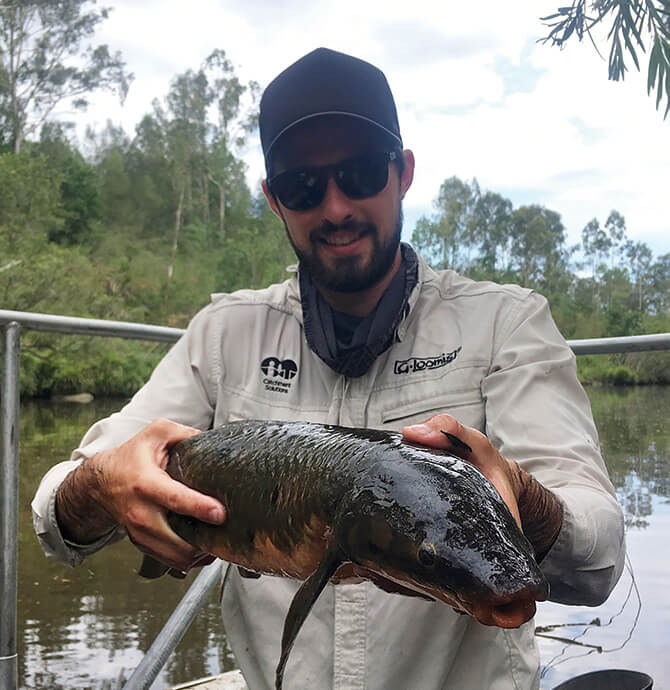
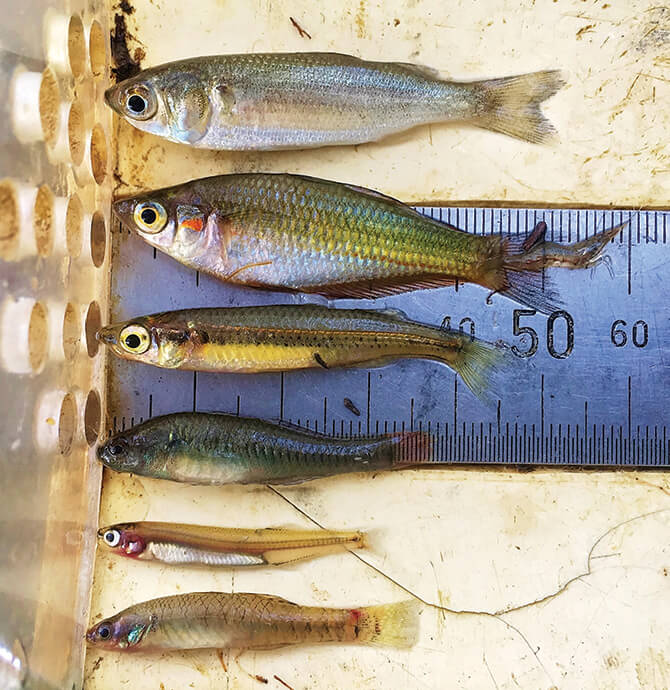
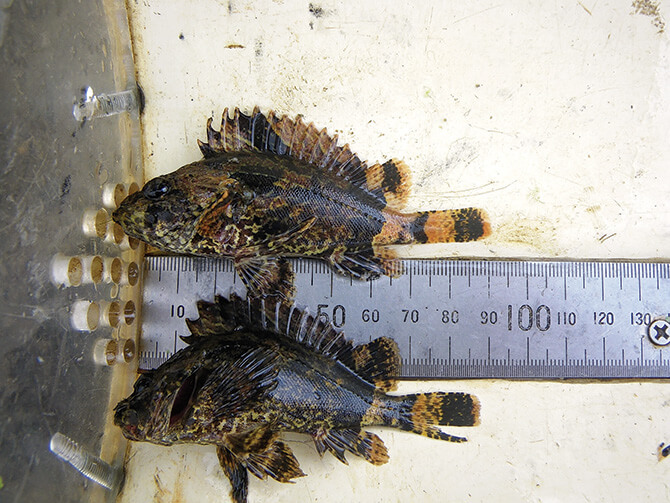
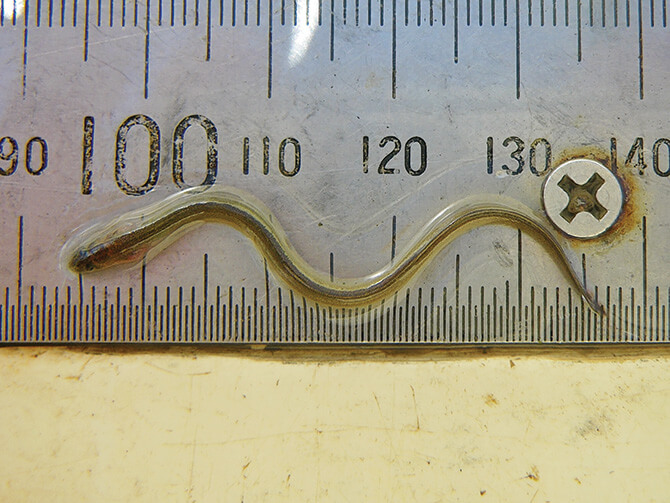
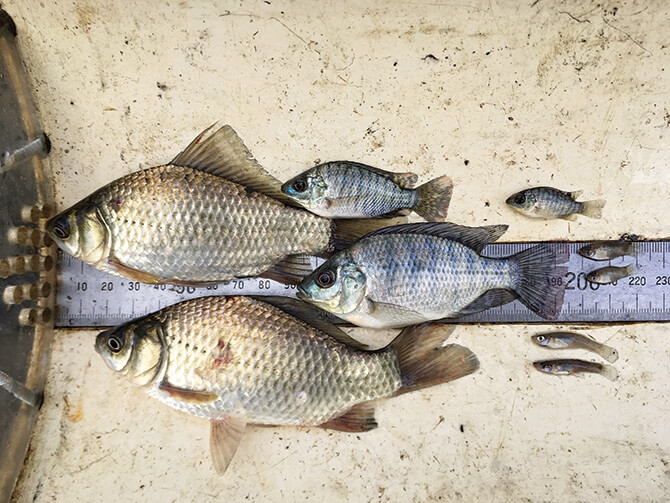
Thank you. This was so helpful. I’ve been trying to identify what fish are in my creek.
Where can I get a native fish water fish guide from it seems impossible to find..
Hi Craig. The Queensland Museum has a great freshwater fish booklet – https://www.thereallygoodbookshop.com.au/product/3520/Freshwater-Fishes-of-the-Greater-Brisbane-Region-A-Queensland-Museum-Pocket-Wild-Guide
I think those are estuary cod not stone fish